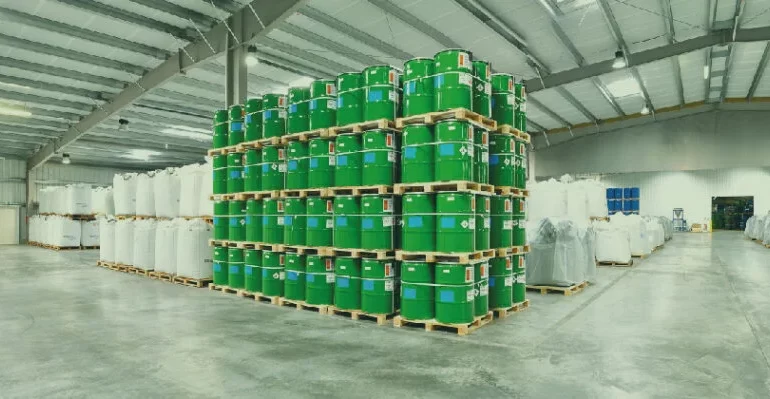At Innoveda Chemicals, safety is our top priority. As a leading safe acid liquid supplier in UAE, we understand that working with acidic liquids can be essential for many scientific and industrial processes. However, it’s crucial to handle these substances with proper care to avoid accidents and injuries.
This blog post outlines the top 5 safety tips you should remember whenever working with acidic liquids. By following these guidelines, you can minimize risks and ensure a safe work environment.
Know Your Acid:
Acids come in various strengths and have different properties. Understanding the specific acid you’re working with is the first step towards safe handling.
- Concentration: Concentrated acids are generally more hazardous than diluted solutions. Always be aware of the concentration of the acid you’re using.
- Corrosiveness: Acids can damage skin, eyes, and clothing on contact. Knowing the level of corrosiveness allows you to choose appropriate personal protective equipment (PPE).
- Reactivity: Some acids react violently with certain materials, including water, metals, and organic solvents. Familiarize yourself with the potential hazards of mixing your acid with other substances.
Knowing these characteristics allows you to choose proper handling procedures and avoid unexpected reactions. Safety Data Sheets (SDS) are valuable for detailed information on specific acids.
Dress for the Job:
Personal protective equipment (PPE) is your first line of defense against acid exposure. Here are the essential PPE items you should wear when working with acids:
- Chemical-resistant gloves: Select gloves made especially for the kind of acid you’re working with. Double gloving adds a degree of defense.
- Safety glasses or goggles: Splashing acid can cause severe eye damage. Choose eyewear that provides a good seal around the eyes. A face shield offers additional protection in case of spills.
- Lab coat or Gloves: Wear a chemical-resistant lab coat or apron to protect your clothing from splashes and spills. For further safety, think about donning long trousers and closed-toe shoes.
Inspect your PPE for any signs of damage before use. Damaged PPE can compromise your safety.
Work in a Well-Ventilated Area:
Many acids release fumes that can be harmful if inhaled. Working in a well-ventilated area is crucial to prevent respiratory problems. Here are some ventilation tips:
- Fume hood: Whenever possible, use a fume hood to contain acid vapors and fumes.
- Open windows: If a fume hood is unavailable, work in an area with good natural ventilation. If at all possible, keep the windows on opposing sides of the room open to provide adequate ventilation.
- Ventilation system: Some workplaces may have dedicated ventilation systems designed for handling hazardous chemicals. Familiarize yourself with any such systems in your work environment.
Adequate ventilation helps to decrease your exposure to harmful acid vapors.
Handle Acids with Care:
Proper handling techniques are essential to minimize the risk of spills and splashes. These are important things to keep in mind:
- Never pour acid directly from a container: Use a graduated cylinder or funnel to transfer acids safely.
- Hold containers securely: Two hands are always recommended when handling containers of acid.
- Never point the container opening towards yourself or others: Maintain a safe distance when transferring acids.
- Clean up spills immediately: Have spill kits readily available for prompt cleanup in case of accidents.
Careful handling practices significantly reduce the risk of accidents when working with acids.
Be Prepared for Emergencies:
Despite taking precautions, accidents can still happen. Being prepared for emergencies is vital to minimize the damage from acid exposure. Here are some important steps:
- Know the location of emergency eyewash stations and safety showers: These are essential for immediately flushing acid from eyes and skin in case of contact.
- Become familiar with emergency protocols: Examine the acid spill emergency response plan for your place of employment and be aware of who to call in the event of an accident.
- Have a first-aid kit readily available: The kit should contain items for treating minor acid spills on the skin, such as sodium bicarbonate solution (baking soda solution) or a neutralizer specific to the acid being used.
Proper emergency preparedness allows for a swift and effective response to minimize the impact of incidents.
Conclusion:
In the end, by following these top 5 safety tips, you can significantly reduce the risks of working with acidic liquids. Remember, safety is always paramount.
At Innoveda Chemicals, we are committed to providing high-quality chemicals and promoting safe handling practices. If you need more information or if you have any questions, don’t hesitate to reach out. As a trusted safe acid liquid supplier in UAE, we prioritize the well-being of our customers and ensure that our products meet stringent safety standards.



